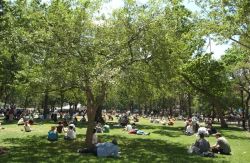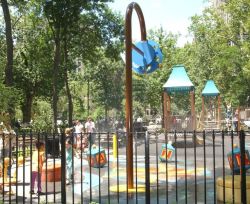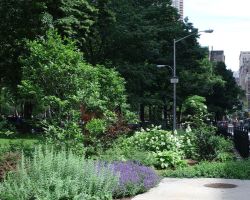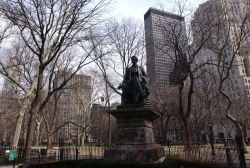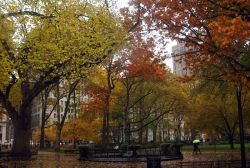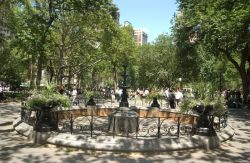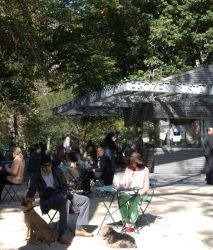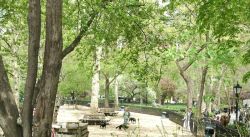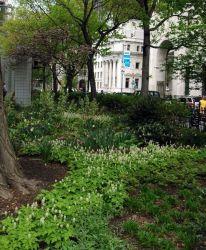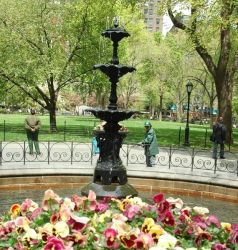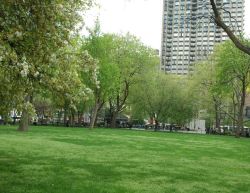Madison Square Park
View all monuments in NYC Parks, as well as temporary public art installations on our NYC Public Art Map and Guide.
Roscoe Conkling
| Artist: | John Quincy Adams Ward |
| Dedicated: | 1893 |
| Location: | Madison Avenue at 23rd Street |
Artwork History
Located at the southeast corner of Madison Square Park this forthright, bronze full-standing statue of political figure Roscoe Conkling (1829-1888) is by the distinguished artist John Quincy Adams Ward (1840-1910), and dates to 1893.
Conkling was born in Albany, New York on October 30, 1829. He studied law with his father Alfred Conkling (1789-1874), a jurist, and entered the law practice of Francis Kernan (later a colleague in the Senate) in 1846. In 1850 he became district attorney for Oneida County, and was admitted to the bar in that year. His political career was launched when he was elected in 1858 Mayor of Utica, New York. He then served as a United States congressman (1859-1863, 1865-67) and senator (1867-1881).
A member of the House ways and means committee and of a special committee on post-war reconstruction, his first major speech was in support of the fourteenth amendment to the Constitution which established equal protection of the laws for all citizens. In the senate Conkling was an ardent supporter of the Grant administration, served on the judiciary committee, helped support passage of a civil rights bill, and played a prominent role in framing the electoral-commission bill of 1877. In 1876 Conkling had garnered 93 votes for the Republican nomination for president at the convention in Cincinnati.
Conkling’s active government role made him the undisputed leader of the Republican party in New York State, and a power-broker who controlled federal patronage. Though married, this charismatic figure was romantically linked to several other women. In 1881 a dispute with President James Garfield (1831-1881) over patronage dispensation and federal appointments caused Conkling to resign from the Senate. Withdrawing in large part from politics, Conkling dedicated the remainder of his life to a successful law practice.
On March 12, 1888, while on his way to the New York Club at 25th Street, Conkling suffered severe exposure in Union Square, during the famous blizzard which gripped the city on that day. As a result his health rapidly declined, and he died on April 18th, 1888. Five years later friends of Conkling petitioned the Mayor and Park Board to erect a sculpture of him in Union Square. Park officials believed Conkling not of a stature to warrant placement of this work alongside existing sculptures in the park of George Washington, Abraham Lincoln and the Marquis de Lafayette, but granted permission at the present location of the work.
Later referred to as “the Dean of American Sculptors,” Ward contributed nine sculptures to the parks of New York, among them Horace Greeley (1890) now in City Hall Park, Alexander Holley (1888) in Washington Square Park, William Earl Dodge (1885), now in Bryant Park, Henry Ward Beecher (1891) in Columbus Park, Brooklyn, and The Indian Hunter (1869), William Shakespeare (1872), The Pilgrim (1885), and the Seventh Regiment Memorial (1874) in Central Park. Ward’s depiction of Conkling is a sensitive and vigorous portrait of him posed, as Conkling’s wife requested, while delivering a speech before the United States Senate. In early December 1893, the eight-foot high, 1,200 pound statue was hoisted onto its granite pedestal, and installed—in deference to the Conkling’s heirs—and installed without any formal ceremony. In the summer of 2000 as part of the redesign and renovation of Madison Square Park the sculpture was relocated 20 feet to a landscaped area, and in 2001 the sculpture was conserved by the Citywide Monuments Conservation Program.
Artwork Details
| Description: | Standing figure (over life size) with integral plinth, on pedestal |
| Materials: | Bronze, Quincy granite |
| Dimensions: | H: 14'11" W: 10'4" D: 10'4" |
| Foundry: | Henry-Bonnard Bronze Company |
| Donor: | Friends |
| Cast: | 1893 |
Inscription
Pedestal:ROSCOE CONKLING
Please note, the NAME field includes a primary designation as well as alternate namingsoften in common or popular usage. The DEDICATED field refers to the most recent dedication, most often, butnot necessarily the original dedication date. If the monument did not have a formal dedication, the yearlisted reflects the date of installation.
For more information, please contact Art & Antiquities at (212) 360-8163.
Check out your park's Vital Signs
Clean & Safe
Green & Resilient
Empowered & Engaged Users
Share your feedback or learn more about how this park is part of a
Vital Park System


